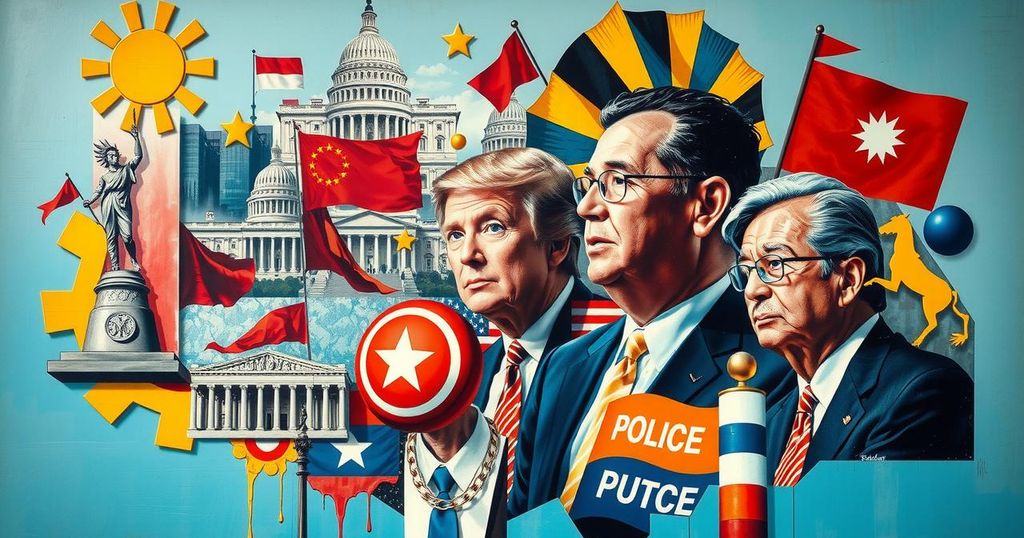Americans Voted for Trump: Did They Vote for This?
As President Donald Trump marks the early days of his second term, Americans are faced with an unprecedented series of changes that may leave many questioning their votes. Have the policies he’s championing veered too far from what they expected? The whirlwind of tariffs, immigration strategies, and government restructuring could reshape the nation significantly, raising concerns among constituents about the ripple effects of these decisions in the long run. At the forefront are pressing issues like rising inflation, a growing divide within the Republican Party, and how the new policies may not be in line with the hopes of his voters.
Understanding Trump’s Rapid Start and Its Implications
The early days of President Donald Trump’s second term are marked by a whirlwind of changes. Each day seems to unfurl with a dramatic new initiative or controversial decision, like a compulsive chess player making moves without fully calculating the consequences. With all of this unfolding, many are left wondering—did the Americans who voted for Trump really sign up for such a radical reworking of the government and society?
The Tariff Dilemma Amidst Growing Inflation
Trump’s latest promise started with a surprising emphasis on tariffs. Last Thursday, he pledged to impose tariffs on foreign automobiles, even amidst rising inflation—a topic he had campaigned on as crucial in winning over voters. This is troubling when considering that economists often argue that tariffs typically elevate prices instead of lowering them. Tariffs and lower prices seem to be contradictory terms, yet Trump appears to be prioritising the former, perhaps hoping to reshape aspects of the economy earlier in his term.
Caught Between Respect for Tradition and Bold Changes
Strangely enough, changes like the renaming of the ‘Gulf of Mexico’ to the ‘Gulf of America’ have been a point of contention among the populace. A recent survey from Marquette University highlights that a solid 71% of Americans are against this name change. Trump’s many ambitious goals—ranging from mass deportation to a significantly smaller federal bureaucracy—coupled with environmental policies that show little concern for climate change, could drastically alter the fabric of the nation as we know it as he takes more control in this term than his predecessor, President Joe Biden.
Parsing Trump’s Approval Ratings and Voter Expectations
Polls indicate that there is dissatisfaction among Americans regarding Trump’s approach to inflation, even as his approval ratings hold steady at around 53%. Notably, a significant 66% of Americans believe that he is not focusing enough on lowering prices. This dissatisfaction transcends party lines, as almost half of Republicans echo these concerns. Meanwhile, many respondents in the same CBS poll felt that Trump is, indeed, fulfilling his promises, indicating that while they support him, they may not be in full agreement with every decision he makes.
The Duality of Immigration Sentiment Among Voters
When it comes to immigration, American opinions are surprisingly complex. In a Marquette poll, 60% support the deportation of undocumented migrants, while a notable 57% are against deporting those who have been in the country for years without a criminal record. This dissonance reflects a larger trend: Trump’s hardline immigration policies, while popular in some districts inhabited heavily by Trump supporters, have spurred anxiety among specific communities—especially vulnerable populations like Venezuelan migrants. Florida Republican Rep. Carlos Giménez has heard these concerns, suggesting there should be different treatments for those who could be in danger if sent back home.
Controversial Policies and Divergence in Public Opinion
There exist some ideas akin to Trump’s that fall flat with the broader populace. For example, moves to bar transgender individuals from military service or to withdraw from vital climate agreements garner less than enthusiastic support; most polls show they appeal to 40% or less of the American public. Although many of these policies have strong backing from Republican circles, even staunch supporters express dissent regarding uninhibited use of artificial intelligence systems. Trump’s brand of populism seems to be contrary to the desires of some traditional Republican Party members, causing a rift in the party’s core ideals, especially among the old guard.
Mitch McConnell: Balancing Between Support and Opposition
Not all Republicans align with Trump, and one prominent figure feeling the strain is Senate Minority Leader Mitch McConnell. Once a major player in the Republican establishment, McConnell finds himself isolated on certain issues, becoming the sole opponent of Trump’s controversial nominations, like vaccine skeptic Robert F. Kennedy Jr. As McConnell voices concerns about the direction Trump is taking and the lack of support for democratic allies abroad, he remains compelled to endorse most of Trump’s agenda. However, he faces challenges as Trump cultivates a foreign policy that is decidedly more pro-Russian than his own views advocate.
Navigating the New Republican Landscape
Self-preservation in politics often means compromise, and McConnell’s subtle yet deliberate criticisms may not hold water with an increasingly populist base. Trump has turned the Republican Party towards a brand of politics that craves broad appeal among working-class voters, causing unease among the party’s traditional circle. Despite the isolated position he finds himself in, McConnell continues to back Trump, signalling either his strategic insights into current Republican sentiments or perhaps just the reality that dans un landscape populated by what feels like only two options left him little choice.
The Lasting Impact of Trump’s Decisions
Trump’s second term thus far could be characterised by unpredictability and a stark divergence between voter expectations and his administration’s actions. The balance between pushing a bold agenda and keeping the public satisfied is a precarious one. It remains to be seen whether this approach will pay off for Trump or contribute to broader discontent among Americans who are grappling with conflicting priorities in light of the administration’s swift changes. This whirlwind of transformations is ongoing, with the final political outcomes still unfurling before our eyes.
Why are Trump’s tariffs raising concerns about inflation?
Trump’s economic policies, especially his tariffs, can lead to increased prices because they impose costs on imported goods that are then passed on to consumers. While aimed at protecting domestic industries, this often backfires by tightening household budgets.
Are voters feeling satisfied about Trump’s current actions?
Despite Trump’s promises, certain polling data reveals that a large chunk of President Trump’s base is uneasy about the speed and scope of his initiatives. As more people feel the impact of inflation, political dynamics may shift.
What is the impact of Trump’s immigration policies on Latino voters?
Trump won a considerable majority in places with significant Latino populations, including Florida, yet policies enacted could alienate these voters over time, especially if their concerns about safety and deportation aren’t considered.
How are Republicans feeling about Trump’s more controversial policies?
It appears many Republicans are supportive of Trump’s broad agenda; however, there is a significant contrast in opinions regarding specific policies. Balancing populist appeals with traditional values is a challenge for the party.
How does Mitch McConnell fit into the current Republican landscape?
McConnell’s position illustrates the difficulties of maintaining influence while the party sways under more populist pressures that often contradict older Republican sentiments, leading to an interesting political dynamic.




